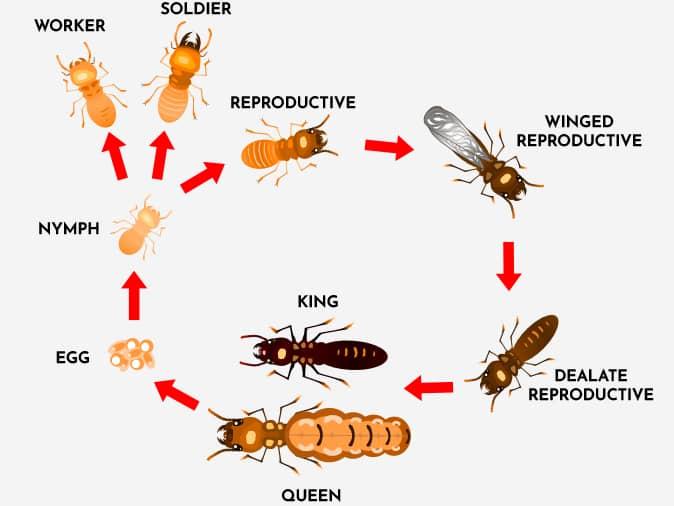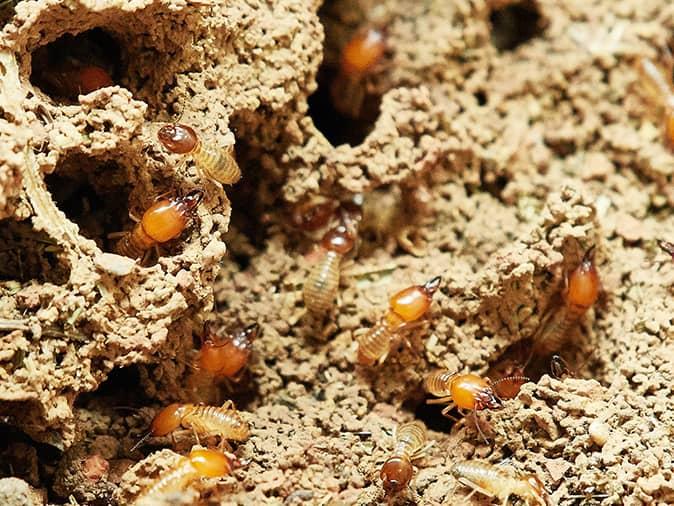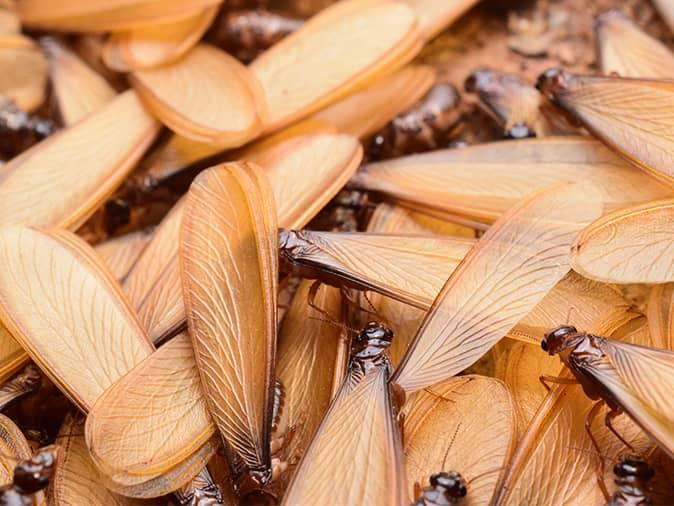Termite Damage In New Jersey Homes
Of all the many things that can destroy a home in the United States, termites are top of the list. The damage caused by termites costs U.S. property owners more than all natural disasters: that's floods, fires, earthquakes, and hurricanes combined. And, the most destructive type of termite is classified as subterranean. These termites are most destructive because they are the sneakiest of all termites. When they come up from the ground to feed on a structure, they don't leave feces pellets on window sills, like drywood termites. Their excrement remains inside their tunnels and nest, allowing subterranean termites to feed on a structure for years without being detected. We recently covered all of the many ways subterranean termites can damage a home or business. In this article, we're going to take a look at their life cycle and glean some things that will help us in our efforts to detect these wood-destroying organisms before they cause irreparable damage.

Eggs
The queen of a subterranean termite colony is a proficient egg layer. She can live to be 25 years old and, in that time, lays as many as 2000 eggs a day. So, a single queen can lay as many as 18,250,000 eggs in her lifetime. But that's not the worst of it. Some colonies have more than one egg-laying female. That's some scary stuff.
Subterranean termite eggs are small, white (or brownish), translucent, and oval-shaped--not that you are likely to see them. The eggs that are laid by a queen will be deep in her nest, which may be 4 to 18 inches below the ground. If you uncover eggs, it is likely that your infestation is severe. While eggs don't damage the structure directly, if they are found near the surface of the ground or underneath a structure in your basement, shed, or outbuilding, it means the nest is right up close to your property. These eggs are likely to be grouped together in a clutch, and they will have a caviar appearance. You're also likely to see the big, fat queen right there with those eggs.
Nymphs
The incubation period for termites differs based on species and environmental conditions but it generally takes 1 to 2 weeks for an egg to hatch into a nymph. When a nymph hatches, it is soft, white, and translucent, with the characteristics of an insect: two antennae, six legs, and three body parts. Apart from being smaller than worker termites, they look the same.
A newly hatched nymph will go through a molting process and shed its skin continually until it develops into a worker. All termites begin as workers and later progress into other forms, as the queen directs, through the emission of pheromones. Pheromones are chemical scents that the queen uses for communication.
Nymphs are unable to feed, so they are not a threat to your property. They must rely on other termites to share food with them through a process called trophallaxis. Like eggs, you aren't likely to see nymphs unless you have a severe infestation. Nymphs stay close to the heart of a colony, awaiting to become worker termites.
Worker termites

A worker termite is pale-white with a rounded head and straight antennae. It looks a little bit like a pale ant, but the waist does not have that ant-like pinch in it. If you uncover worker termites in the walls of your home, garage, shed, outbuilding, or other wooden structures, you can conclude that you have an infestation. But, the presence of termite workers does not mean you have a colony close to your home. Workers can travel as much as the distance of a football to acquire food.
Worker termites do not like the light. So, you aren't likely to see them unless you rip out a wall or a floor. Workers will feed on wood until they get to the paint and stop short of allowing the light into their tunnels. For this reason, you're going to see the damage they do, long before you see these insects.
Warning signs of termite worker activity in your home
- Bubbling paint or wallpaper.
- Baseboards that have honeycomb-like indentations.
- Tunnels, trenches, or channels carved out of damp wood. A good example of this is the base of fence posts where they are in the moist soil.
- Tunnels, trenches, or channels carved out of dead wood, like a stump, log, or pile of firewood.
- Holes in wood-based products and other objects with cellulose in them, like fabrics. While termite won't chew on hanging clothing in your closet, they could chew out of a wall or floor and enter into a pile of clothing in order to feed on it.
- The presence of live termites. If you chop into a piece of wood in your yard and you see pale insects with legs, you should definitely recognize that as a warning sign.
Workers are the only termites that damage your property because they are the only termites that feed on your property.
Soldiers
Termites make a tasty snack for many predators. It is the role of the soldier termites to prevent this from happening. As needed, a termite queen directs worker termites to transform into soldiers. Soldiers are larger than workers and have a big distinct orange head with black pointed mandibles.
There are two main ways Soldiers protect their colony. They will attack predators using their powerful mandibles or they will use their big heads to plug tunnel holes, preventing predators from getting in.
While they are much less populous than workers and not directly responsible for termite damage, their larger size, distinct appearance, and tendency to guard entry/exit points to the nest makes them the most likely type of termite for most homeowners to come across in the event of an infestation.
Warning signs of soldier termite activity
-
If a termite infestation is large enough, you may hear soldier termites banging their heads or shaking their bodies against tunnel walls. They do this to warn other termites of danger. When enough of them do this, it can sound like a rattling noise. In most cases, there are not usually enough soldiers concentrated in one location for this rattling to be heard without the use of a stethoscope or some other form of amplification.
-
Since soldiers plug holes with their big heads, you may see a soldier poke his head out of a hole. If you do, take notice.
Reproductives

When it comes to protecting your home from termites, reproductives are the most important termite to recognize. Unlike other termites, reproductives (also called alates) love the light and the fresh air. They're not going to have a problem crawling around in places where you'll notice them. When you see them, be aware that it is usually a sign of a current infestation, not a pending one. Reproductives gather into swarms (usually in spring or summer) for only about 30 minutes before shedding their wings, mating, and establishing new nests. That means they are usually found close to the colony that sent them out.
Reproductives are black with long white wings that stack on top of each other. These wings hang well beyond the abdomen and are rounded at the tips.
Swarmers are often mistaken for winged ants, though they shouldn't be. These reproductive termites do not have the pinched waist of an ant and the wings of an ant have a cleft at the tips.
Warning signs of swarmer activity
- In spring, and in May specifically, homeowners are likely to see swarms take place. Since swarmers are attracted to light, they may be found fluttering around an exterior light at night or crawling on an interior window during the day. If you find swarmers on an interior window, it is important to understand that they didn't accidentally get into your home. They were birthed inside your home and are trying to get out to the light.
- Since swarms only last about 30 minutes, shed wings are sometimes the only sign a homeowner gets. These wings can be found in many locations both inside and outside of a home. One helpful place to look for these wings is in spider webs. Webs are nature's sticky traps.
- If you pull up some mulch or move a pile of wood and find hundreds of white winged insects crawling around, you've found a mature termite colony that has not yet sent those reproductives out. If you find them close to your home, there is a good chance you have a severe infestation.
The best way to protect your home from termites
There are many warning signs that termites leave behind at every stage of their life cycle, but they are subtle signs at best. Most termites live in the ground or inside wood, and only come out in dark, moist locations. Swarmers are the only termites you're likely to ever see, and they only make an appearance for a few minutes. Year round prevention is the best way to safeguard your equity from these sneaky, destructive pests.
Arrow Premier
If you’re looking for a program that protects your home and family from common household pests PLUS termites and other wood-destroying insects, we recommend Arrow Premier. With this program, you get quarterly pest control and a wood-destroying insect program in one package!
- Protects your home all year long.
- Consists of full interior and exterior inspections and treatments.
- Covers your entire property* including the attic, mailbox, play set, shed, and fence.
- Includes a certified termite inspection and ongoing termite control.
Pests targeted with Arrow’s Premier includes cockroaches, silverfish, spiders, earwigs, clover mites, millipedes, centipedes, crickets, ground beetles, boxelder bugs, ants (including carpenter ants, pharaoh ants and acrobatic), fleas (inside only), pillbugs, sow bugs, fruit flies, stored product pests, bees, wasps, hornets, carpenter bees (no higher than 10ft), mice, and rodents PLUS termites
*If you have a pool house that requires service, pricing would increase based upon the size of the structure.


Testimonials
Request Your FREE Estimate
Additional Services
Our solutions are designed for even your toughest pest problems.
Don’t let pests affect your quality of life, here's how we can help:
